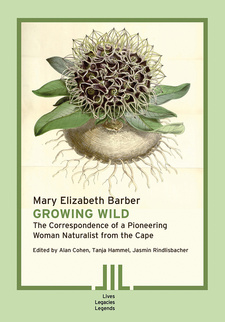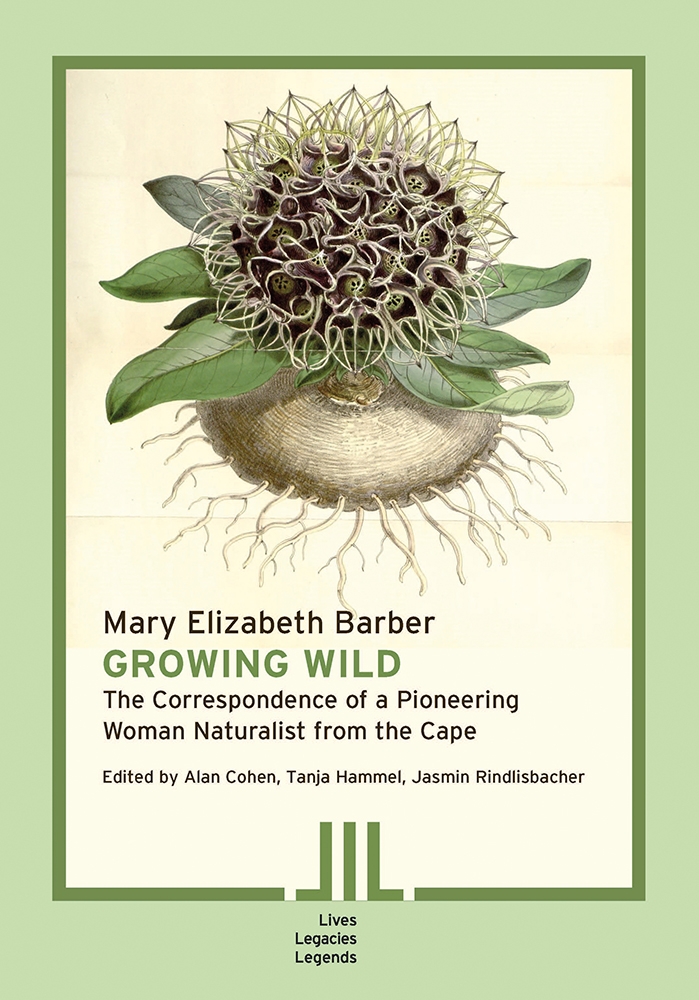Mary Elizabeth Barber: Growing Wild. The Correspondence of a Pioneering Woman Naturalist from the Cape, by Alan Cohen, Tanja Hammel and Jasmin Rindlisbacher

Mary Elizabeth Barber: Growing Wild. The Correspondence of a Pioneering Woman Naturalist from the Cape, by Alan Cohen, Tanja Hammel and Jasmin Rindlisbacher. Publisher: Basler Afrika Bibliographien
The following is an excerpt from the introduction to: Mary Elizabeth Barber: Growing Wild. The Correspondence of a Pioneering Woman Naturalist from the Cape, by Alan Cohen, Tanja Hammel and Jasmin Rindlisbacher.
Mary Elizabeth Barber loved observing birds and butterflies on horseback. She ensured that she blended into the landscape, presumably by wearing clothes which matched her environment. On foot, she walked slowly and silently, although she may have imitated bird vocalisations. She would conceal herself by leaning against a tree or pulling a branch down in front of her. If her position offered her a good view, she probably remained there for several hours. At night, she transcribed a neat copy of her notes from the day in one of her notebooks. She later revised these notes when writing her letters and papers. Her letters were neatly written in beautiful handwriting. She would also often add ink sketches, watercolours or specimens to her letters to illustrate her observations: From the 1830s to the 1880sr the line between who was considered to be an amateur and who was regarded as a professional scientist was still being drawn. There were very few individuals who could claim to earn a living from science at the time, and those who did enjoyed only a low social standing in a scientific community which was still dominated by unpaid gentlemen scientists such as Charles Darwin. There were no precedents for the kind of career which Barber was trying to construct for herself. She never held an official position and only seems to have been compensated for her specimens and papers on rare occasions. There were very few younger women in Barber's lifetime who could earn a living through science. In the Cape Colony, only few women managed to do so: for instance, Mary Glanville (1861-1888), who was curator of the Albany Museum in Grahamstown from 1882 until her death, and the linguist Lucy Lloyd (1834-1914), who was employed as curator of the Grey Collection at the South African Public Library from 1875 to 1880 (at half her predecessor's salary). In the USA, Mary Treat (1830-1923), a naturalist from New Jersey who made significant contributions to entomology and botany, earned a living through her scientific writing, while in England the palaeontologist Mary Anning (1799-1847) made her living as a collector of and dealer in fossils. Strikingly, Glanville and Lloyd were single women, Treat was divorced, and Anning never married. Mary Barber was married and had three children: Frederick Hugh (1847-1919), Henry Mitford (1850-1920) and Mary Ellen Bailie (nee Barber) (1853-1938). Yet marital problems and financial difficulties challenged Barber throughout her career. She had married Frederick William Barber (1813-1892) in 1842. Her well-educated husband, who regularly wrote articles on a variety of subjects for local newspapers and had an interest in agricultural matters such as soil fertility, was described as a "somewhat retiring, studious man".20 Their marriage appears to have been a pragmatic arrangement. In Frederick's sole remaining description of his wife, she is portrayed as a tomboy who would "rather climb the trackless mountain 'all unseen' than figure a quadrille in a heated room" and as "a plain, simple-minded, [...] slight and rather tall, [...] well informed [...] girl".21 Frederick struggled to make a living as an independent farmer, and, by the time of the Seventh Cape-Xhosa War, the Barbers had twice been "reduced to the verge of ruin".22 Frederick also supported his brother Hugh, who had followed him to the Cape in 1840 and continued to represent a considerable burden on the family income. [...]
This is an excerpt from Mary Elizabeth Barber: Growing Wild. The Correspondence of a Pioneering Woman Naturalist from the Cape, by Alan Cohen, Tanja Hammel and Jasmin Rindlisbacher.
Title: Mary Elizabeth Barber
Subtitle: Growing Wild. The Correspondence of a Pioneering Woman Naturalist from the Cape
Series: Lives Legacies Legends Vol. 13
Editors: Alan Cohen, Tanja Hammel, Jasmin Rindlisbacher
Publisher: Basler Afrika Bibliographien
Basel, Scwitzerland 2020
ISBN 9783906927046 / ISBN 978-3-906927-04-6
Softcover, 17 x 24 cm, 303 pages, several colour and b/w images
Cohen, Alan und Hammel, Tanja und Rindlisbacher, Jasmin im Namibiana-Buchangebot
Mary Elizabeth Barber: Growing Wild. The Correspondence of a Pioneering Woman Naturalist from the Cape
A biographical study: Mary Elizabeth Barber: Growing Wild. The Correspondence of a Pioneering Woman Naturalist from the Cape.

